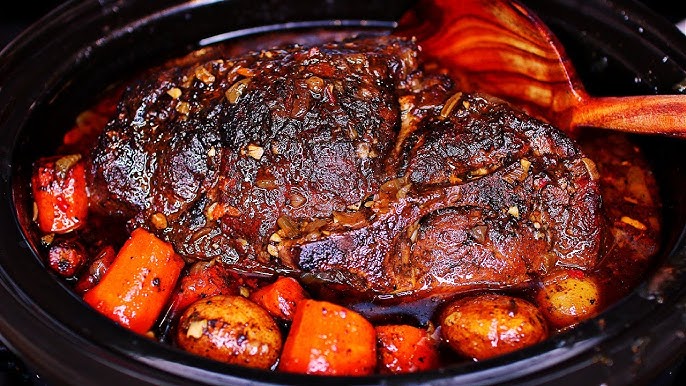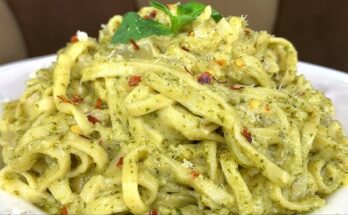Beef Tenderloin Roast Recipe: Beef tenderloin is the crown jewel of red meat. Often featured at festive dinners and elegant events, this cut is known for its incredible tenderness, mild flavor, and melt-in-your-mouth texture. If you’ve ever had filet mignon, then you’ve tasted part of the tenderloin—it’s that center-cut portion that restaurants charge a premium for. But when you buy the entire roast, not only do you save money, but you also get to enjoy the whole flavorful experience in your own kitchen.
Preparing a beef tenderloin roast at home might sound intimidating, but with the right steps and techniques, anyone can master it. Whether you’re making it for a holiday dinner, a birthday celebration, or just because you want to treat yourself, this step-by-step guide will walk you through everything you need to know to serve up a perfect roast. The key? Simplicity. You don’t need complicated ingredients or gadgets. Just quality meat, basic seasonings, and a little kitchen know-how.
Choosing the Right Cut of Beef Tenderloin
What to Look for When Buying
When it comes to choosing the perfect beef tenderloin, there are a few things to keep in mind. First off, look for a roast that has good marbling. These thin white lines of fat running through the meat are your best friend—they melt as the meat cooks, keeping it juicy and flavorful. Also, make sure it has a uniform thickness so it cooks evenly. A tenderloin that’s too thick on one end and thin on the other will give you overcooked slices on one side and undercooked on the other.
Another important factor is the grade of beef. USDA Prime is the top tier, offering the best marbling and tenderness. Choice is a good runner-up and usually easier to find in stores. If you see “Select,” steer clear for this type of dish—it’s leaner and less flavorful, which isn’t ideal when you’re going all out with a roast like this.
Trimmed vs. Untrimmed Tenderloin
You’ll also come across both trimmed and untrimmed tenderloins. A trimmed tenderloin—often labeled “peeled” or “peeled and tied”—comes ready to cook. It’s more expensive, but it saves you time and effort. Untrimmed tenderloins, on the other hand, still have the silverskin (a tough membrane) and excess fat attached. They’re cheaper but require some prep work before roasting.
If you’re up for a bit of butchery, buy untrimmed. Not only do you save money, but you also get to use the scraps for other meals—think stir-fries, stews, or even homemade beef stock. But if you’re in a hurry or new to handling meat, go for the pre-trimmed option. It’ll save you stress on cook day.
Ingredients You’ll Need
Essential Ingredients
For a classic beef tenderloin roast, simplicity is key. You don’t need a ton of spices or ingredients. Here’s what you absolutely need:
- 1 (4-5 lb) beef tenderloin roast (trimmed)
- 2 tablespoons olive oil
- 2 teaspoons kosher salt
- 1 teaspoon freshly ground black pepper
- 4 garlic cloves, minced
- 1 tablespoon fresh rosemary, chopped
- 1 tablespoon fresh thyme, chopped
These ingredients work together to form a flavorful crust that enhances the meat without overpowering it. Fresh herbs bring a fragrant, earthy flavor, while garlic adds a rich, savory kick.
Optional Add-ons for Extra Flavor
Want to kick things up a notch? Here are some additions that can elevate your roast:
- Dijon mustard: Brush it on before adding herbs for a tangy, flavorful base layer.
- Butter: Baste the roast with melted butter infused with garlic and herbs.
- Crushed peppercorns: For a spicy, steakhouse-style crust.
- Red wine reduction or demi-glace: A rich sauce makes the roast even more luxurious.
These extras aren’t required, but they’re fun to experiment with if you’re feeling fancy. Just remember, the star here is the tenderloin. Keep it center stage.
Preparing the Beef Tenderloin
How to Trim (If Necessary)
If you bought an untrimmed tenderloin, the first step is to remove the silverskin—a thin, silver-colored membrane running along the surface of the meat. This part doesn’t break down during cooking, so it’s important to remove it. Use a sharp boning knife and slide it just under the edge of the silverskin. Angle the blade slightly upward to avoid cutting into the meat, and slice along the length, pulling it up as you go.
You’ll also want to trim off any large, thick pieces of fat. A little fat is good, but too much can make the crust greasy and uneven. Don’t toss those trimmings—they’re great for adding flavor to soups or stews.
Tying the Roast for Even Cooking
Once trimmed, your tenderloin may look a little uneven. That’s where tying comes in. Use butcher’s twine to tie the roast every 1 to 2 inches along its length. This helps it hold a uniform shape, which ensures even cooking. Think of it like giving the roast a supportive hug—it keeps everything tight and in place as it cooks.
If your tenderloin has a thinner tail end, you can fold it under and tie it to the main body of the roast. This helps prevent overcooking that part while the thicker center is still roasting.
Marinating or Seasoning the Meat
For a classic flavor, stick with a dry rub of salt, pepper, garlic, and herbs. You can season the roast a day ahead and leave it in the fridge, uncovered. This dry-aging technique helps concentrate the flavor and dry out the surface slightly for a better sear.
If you prefer a wet marinade, go with something simple—olive oil, garlic, herbs, and maybe a splash of balsamic vinegar. Just don’t marinate it for more than 6 hours. This cut is delicate and can turn mushy if soaked too long.
Cooking Techniques
Searing Before Roasting
Searing is one of those little chef tricks that makes a big difference. Before you put your beef tenderloin in the oven, give it a hard sear in a hot skillet. This creates a beautiful crust that locks in the juices and adds a savory depth to every bite.
To do this, heat a large cast-iron skillet over medium-high heat until it’s screaming hot. Add a tablespoon of olive oil, then carefully lay in the tenderloin. Let it sear, undisturbed, for 2–3 minutes per side. Rotate to get all the edges, even the ends. This process only takes about 10 minutes but adds restaurant-level flavor and appearance to your roast.
Some people skip this step and go straight to roasting, but if you want that crave-worthy golden-brown exterior, searing is the way to go. Trust me, it’s worth the extra effort.
Roasting Temperatures and Times
Now, let’s talk oven. Preheat your oven to 425°F (220°C) if you’re going for a medium-rare to medium doneness. After searing, transfer the roast to a wire rack set over a baking sheet or into a roasting pan. If you used a cast-iron skillet for searing, you can pop the whole pan right into the oven.
Here’s a rough guide for roasting times:
- Rare (120–125°F): 25–30 minutes
- Medium-Rare (130–135°F): 30–35 minutes
- Medium (135–140°F): 35–40 minutes
- Medium-Well (145–150°F): 40–45 minutes
Keep in mind that every oven is different, and the shape and size of your tenderloin will affect cooking time. The best way to nail it every time? A meat thermometer. More on that next.
Checking Doneness
Using a Meat Thermometer
A meat thermometer is not optional here—it’s essential. Because tenderloin is so lean, overcooking can happen fast, and there’s no going back from a dry roast. Insert the thermometer into the thickest part of the roast, avoiding any fat or the pan surface.
Use a digital instant-read thermometer for the most accurate results. Start checking the temperature around the 25-minute mark, and pull it when it’s 5–10°F below your target. The roast will continue to cook a bit as it rests.
Desired Internal Temperature by Preference
Here’s a quick reference for your desired level of doneness:
| Doneness | Temperature to Pull from Oven | Final Temperature After Resting |
|---|---|---|
| Rare | 120–125°F | 125–130°F |
| Medium-Rare | 130–135°F | 135–140°F |
| Medium | 135–140°F | 140–145°F |
| Medium-Well | 145–150°F | 150–155°F |
| Well-Done | 155°F+ | 160°F+ |
Medium-rare is the gold standard for tenderloin—it’s juicy, pink, and fork-tender. But if your guests prefer it more done, just adjust the cooking time and thermometer accordingly.
Resting and Slicing the Roast
Why Resting Is Crucial
As tempting as it is to carve right into your beef tenderloin the moment it comes out of the oven, resist! Letting the meat rest for at least 15–20 minutes allows the juices to redistribute evenly. If you cut into it too soon, all those flavorful juices will spill out onto the cutting board instead of staying inside the meat.
Loosely tent the roast with aluminum foil and let it sit. It will stay warm, and the internal temperature will rise slightly during this time—this is called carryover cooking.
How to Slice for Maximum Tenderness
Once rested, it’s slicing time. Use a very sharp carving knife or chef’s knife. Cut against the grain into ½-inch to ¾-inch thick slices. Cutting against the grain shortens the muscle fibers and ensures each bite is as tender as possible.
Serve your slices on a warm platter, garnish with fresh herbs, and maybe a drizzle of pan juices or a simple sauce. You just made a centerpiece worthy of any special occasion!
Serving Suggestions
Best Side Dishes to Pair
A roast this good deserves some top-notch side dishes. Here are a few all-time favorites:
- Garlic Mashed Potatoes – Creamy, buttery, and a perfect match.
- Roasted Brussels Sprouts – Adds a nice crunch and earthy flavor.
- Yorkshire Pudding – A British classic that soaks up the juices beautifully.
- Creamed Spinach – Rich and velvety, a steakhouse staple.
- Honey-Glazed Carrots – A touch of sweetness to balance the savory meat.
Mix and match depending on the vibe you want—comfort food feast or elegant fine dining.
Wine Pairing Recommendations
What wine goes best with beef tenderloin? Since it’s a lean cut, it pairs beautifully with reds that are smooth and not too tannic:
- Pinot Noir – A lighter red that complements the meat without overpowering it.
- Cabernet Sauvignon – Bold and full-bodied, great if your roast is well-seasoned.
- Merlot – Soft, juicy, and always a safe bet.
Choose a wine you love, and you really can’t go wrong.
Storing and Reheating Leftovers
Storage Tips
Beef tenderloin leftovers are pure gold, and storing them the right way ensures they stay delicious for the next round. First, let any leftovers cool completely before storing. Don’t leave the roast out for more than two hours—food safety is key.
Wrap the meat tightly in aluminum foil or plastic wrap, then place it in an airtight container. Store it in the refrigerator for up to 4 days. For longer storage, you can freeze it, though freezing might slightly affect the texture. To freeze, wrap it in foil and then place it in a heavy-duty freezer bag. Squeeze out as much air as possible to prevent freezer burn.
Pro tip: Slice before storing so it’s easier to reheat individual portions without overcooking the whole piece again.
How to Reheat Without Drying Out
Reheating tenderloin can be tricky—you want to warm it up without losing that perfect tenderness. Skip the microwave unless you’re in a serious rush. The best way is to reheat it slowly in the oven:
- Preheat your oven to 250°F (120°C).
- Place the slices in a baking dish with a splash of beef broth or pan juices.
- Cover the dish tightly with foil to trap moisture.
- Heat for about 20–30 minutes, depending on thickness.
You can also reheat individual slices in a skillet over low heat with a bit of butter, flipping gently until warmed through. Just be careful not to overcook—it’s already been roasted to perfection!
Common Mistakes to Avoid
Even the best cuts can be ruined by small slip-ups. Here are some common mistakes to dodge:
- Skipping the meat thermometer: This is the #1 way people overcook or undercook their roast. Invest in a good digital thermometer—it’s a game-changer.
- Not tying the roast: An untied tenderloin cooks unevenly. Always tie it to maintain a uniform shape.
- Over-seasoning: Tenderloin is mild, but you don’t need to drown it in seasoning. Keep it simple—salt, pepper, garlic, herbs.
- Cutting too early: Always let your roast rest before slicing. This seals in the juices and gives you a much better texture.
- Cooking straight from the fridge: Let your roast come to room temperature before searing or roasting to ensure even cooking.
Avoid these missteps and you’re on your way to roast mastery.
Final Tips for a Perfect Roast
- Use high-quality beef: The better the beef, the better the flavor. Go for USDA Prime or Choice grade if you can.
- Season ahead: Letting the roast sit with salt and herbs overnight enhances flavor and helps build a better crust.
- Let the meat breathe: Don’t overcrowd your pan or roasting tray—give it room so heat circulates evenly.
- Make a sauce: A simple red wine reduction, mushroom gravy, or horseradish cream can take your roast to the next level.
- Practice makes perfect: The more you roast, the better you’ll get. Don’t be afraid to try it for smaller dinners before a big holiday event.
Mastering beef tenderloin roast isn’t just about following steps—it’s about trusting your instincts, using your senses, and enjoying the process. Once you’ve nailed it, it’s a meal that’ll earn you applause every time.
FAQs about Beef Tenderloin Roast Recipe
1. Can I prepare the tenderloin ahead of time?
Absolutely! You can season the roast a day in advance and leave it in the fridge uncovered. This enhances flavor and creates a drier surface for better searing. Just let it sit at room temperature for about 30–45 minutes before cooking.
2. Should I use a marinade or dry rub?
A dry rub is usually preferred for tenderloin since it enhances the natural flavor without overwhelming it. Marinades can be used, but keep them light and short—no more than 6 hours to avoid altering the meat’s texture.
3. Can I cook it on the grill instead of the oven?
Yes! Grilling adds a smoky depth that’s hard to beat. Use indirect heat and grill the tenderloin over medium heat with the lid closed, turning occasionally until the desired internal temperature is reached. Sear over direct heat at the end if you want a crispy crust.
4. How do I make a sauce to go with it?
Try a red wine reduction: sauté shallots and garlic in butter, add red wine and beef broth, and simmer until reduced by half. Finish with a pat of butter and herbs. Or go classic with a creamy horseradish sauce or a peppercorn gravy.
5. What’s the best way to serve it at a party?
Slice it ahead and arrange the pieces on a warm serving platter. Serve with sides buffet-style or pass a platter around the table. Offer a few sauce options and let guests build their own plates. It’s elegant, easy, and always a hit.
Conclusion
There’s nothing quite like carving into a beautifully cooked beef tenderloin roast. It’s tender, flavorful, and always makes an impression. Whether you’re serving it at a holiday dinner, a romantic evening, or a family gathering, it’s the kind of dish that turns a regular night into a memorable occasion.
By following this step-by-step guide—from selecting the right cut to seasoning, roasting, and serving—you’ll be able to prepare a restaurant-quality roast right in your own kitchen. Don’t be intimidated—embrace the challenge, enjoy the process, and get ready for some serious compliments.
So the next time you’re looking to impress or simply treat yourself to something special, this beef tenderloin roast recipe is your go-to. Happy cooking!



